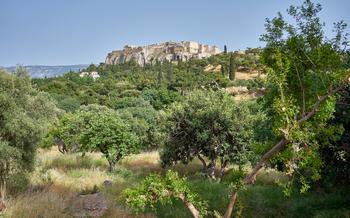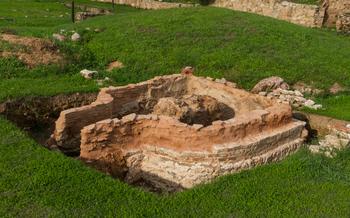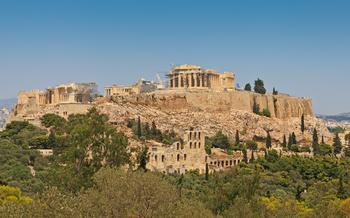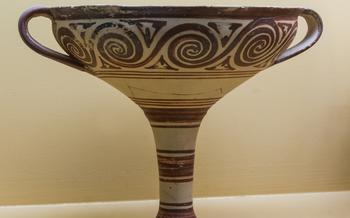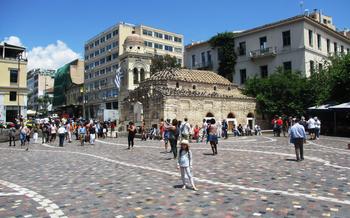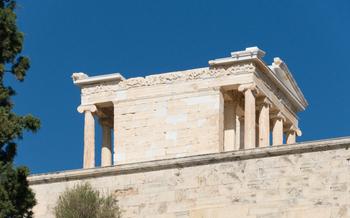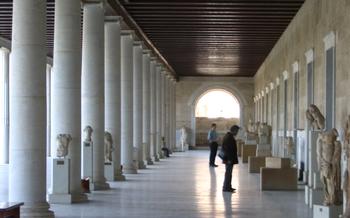
Roman Agora
- Historical Significance
- Location and Access
- Admission and Timings
- Architectural Highlights
- Temple of Hephaestus
- Odeon of Agrippa
- Gate of Athena Archegetis
- Beulé Gate: A Passage Through Time
- Street of the Panathenaia
- Heroön of Atticus
- Museum of the Ancient Agora
- Nearby Attractions
- Insider Tip: Unveiling the Secrets of the Roman Agora
Historical Significance
The Roman Agora, a testament to the grandeur of ancient Athens, stands as a reminder of the city's rich history and cultural heritage. Its origins date back to the 1st century BC, when the Roman Empire conquered Greece and transformed Athens into a provincial capital. The Agora, once the heart of the ancient city, served as a bustling marketplace, a center for political discourse, and a vibrant social hub. Over the centuries, the Roman Agora underwent several transformations, reflecting the changing fortunes of Athens and the ebb and flow of its rulers. Architectural remnants from different periods, including Roman, Byzantine, and Ottoman, tell the story of a city that has endured and evolved through the ages.
In contrast to the Ancient Agora, which was the focal point of Athenian life during the Classical period, the Roman Agora emerged as a distinct entity, catering to the administrative and commercial needs of the Roman provincial government. While the Ancient Agora was primarily a place of assembly and philosophical debate, the Roman Agora became a center of trade, commerce, and civic administration, reflecting the changing priorities and power dynamics of the Roman era.
Location and Access
The Roman Agora is conveniently situated in the heart of Athens, at Adrianou Street, near the Ancient Agora and Monastiraki, making it easily accessible on foot from many major attractions in the city center. To reach the Roman Agora by public transport, take the metro to Monastiraki station on Line 1 (Green Line) or Line 3 (Blue Line). From there, it is a short walk to the site. Alternatively, you can take bus routes 26, 70, and 100 to the Monastiraki stop. Limited parking is available in the surrounding streets, but it is advisable to use public transport or explore the area on foot to avoid the hassle of finding a parking spot.
Admission and Timings
Currently, admission to the Roman Agora is set at €8 for adults, with concessions available for students and seniors. On the first Sunday of every month, entry is free of charge. The site is generally open to the public from 8:00 AM to 8:00 PM daily, although it's worth noting that hours can vary slightly during the winter months.
To fully appreciate the Roman Agora's ancient splendor, plan your visit strategically. Early mornings or late afternoons offer the most pleasant conditions, as the crowds tend to be smaller, and the sun is less intense. For photography enthusiasts, the golden hour, just before sunset, casts a magical glow on the ruins, creating stunning photo opportunities.
Before embarking on your journey through the Roman Agora, check the official website for any temporary closures or special events that may impact accessibility. This way, you can ensure a seamless and enjoyable visit to this captivating historical site.
Architectural Highlights
Within the Roman Agora, several architectural marvels stand as testaments to the grandeur and sophistication of ancient Athens. One of the most striking structures is the Tower of the Winds, an octagonal marble tower that served as both a sundial and a water clock. This ingenious invention, constructed in the 1st century BC, featured eight sundials on its exterior, each facing a different direction, as well as a water clock inside. Its intricate carvings and reliefs depict the eight wind gods and provide valuable insights into ancient Athenian meteorology.
Another architectural gem is the Fethiye Mosque, originally built as a Byzantine church dedicated to the Virgin Mary. During the Ottoman period, it was converted into a mosque and underwent significant modifications, including the addition of a minaret and Islamic decorative elements. The mosque's striking architecture blends Byzantine and Islamic influences, showcasing the cultural diversity of Athens throughout history.
The Library of Pantainos, built in the 2nd century AD, was a significant cultural center in ancient Athens. It housed a vast collection of scrolls and served as a meeting place for philosophers, scholars, and students. Connected to the Stoa of Attalos, the library provided a tranquil space for intellectual pursuits and was a testament to the importance of education in ancient Athenian society.
Temple of Hephaestus
Within the confines of the Roman Agora, the Temple of Hephaestus stands as a testament to the ancient city's reverence for craftsmanship and industry. Erected in the 5th century BC, this Doric temple is among the best-preserved ancient Greek temples in existence, its grandeur rivaling that of the renowned Parthenon.
Majestic columns, crafted with precision, encircle the temple, their fluted surfaces casting intricate shadows upon the worn stone floor. The pediments, though weathered by time, still hint at the vibrant narratives that once adorned them, depicting the labors of Hephaestus, the divine patron of blacksmiths and metalworkers.
Unlike many other temples in Athens, the Temple of Hephaestus has remained largely intact, its structure bearing witness to the architectural prowess of ancient Greek builders. Its resilience can be attributed to its transformation into a Christian church during the Byzantine era, a fate that spared it from the destruction that befell many pagan temples.
Today, visitors can marvel at the temple's well-preserved features, including its intricate roof tiles and the remnants of its interior decoration. Ongoing restoration efforts aim to preserve this architectural masterpiece for future generations, ensuring that its legacy as a symbol of ancient Athenian craftsmanship endures.
Odeon of Agrippa
The Odeon of Agrippa, nestled within the Roman Agora, served as a prominent concert hall and performance space during ancient times. Its construction, commissioned by Marcus Agrippa, a close friend of Emperor Augustus, speaks to the cultural significance of the Roman Agora as a hub for entertainment and the arts.
The Odeon's architectural design, characterized by a semi-circular seating arrangement and a stage, reflects its intended purpose as a venue for musical performances, recitals, and theatrical productions. Its well-preserved structure allows visitors to envision the vibrant atmosphere that once filled this space, as musicians and actors graced the stage, captivating audiences with their talents.
Beyond its architectural beauty, the Odeon of Agrippa holds historical significance. It stands as a testament to the Roman Empire's patronage of the arts and its commitment to providing cultural enrichment for its citizens. The Odeon's enduring legacy as a performance space ensures that it remains a vibrant and integral part of the Roman Agora's allure, inviting visitors to immerse themselves in the cultural heritage of ancient Athens.
Today, the Odeon of Agrippa continues to serve as a venue for cultural events and performances, echoing the spirit of its ancient past. Visitors are treated to concerts, plays, and other artistic endeavors that bring the Odeon's rich history to life, showcasing the enduring power of the arts to captivate and inspire.
Gate of Athena Archegetis
As you enter the Roman Agora through its main entrance, the Gate of Athena Archegetis welcomes you with its imposing presence. This monumental gateway, dedicated to Athena Archegetis, the patron goddess of Athens, served as a symbolic threshold into the bustling heart of ancient Athenian life. Its well-preserved arch, flanked by elegant Ionic columns, stands as a testament to the architectural prowess of the Roman era.
The gate's strategic location at the intersection of the Panathenaic Way and the Roman Agora highlights its significance as a passageway connecting the city's sacred and civic realms. The Panathenaic Way, a processional route used during the grand Panathenaic Festival, led directly through the gate, emphasizing its role in religious ceremonies and public celebrations.
As you step beneath the arch, take a moment to admire the intricate carvings that adorn the gate's facade. These decorative elements, often depicting mythological scenes or symbolic motifs, provide a glimpse into the artistic sensibilities of the ancient Athenians. The gate's dedication to Athena Archegetis, whose name translates to "Athena the Foundress," further underscores the deep reverence that the Athenians held for their patron deity.
Standing before the Gate of Athena Archegetis, you can almost sense the footsteps of ancient Athenians as they passed through this gateway, eager to engage in commerce, politics, and social interactions within the vibrant Roman Agora. Let your imagination transport you back in time as you explore this remarkable site, where history and mythology intertwine to create a captivating tapestry of ancient Athenian life.
Beulé Gate: A Passage Through Time
At the southern end of the Roman Agora, the Beulé Gate stands as a testament to the enduring legacy of ancient Athens. Named after the French archaeologist Ernest Beulé, who excavated the site in the 19th century, this monumental gateway once served as the main entrance to the Agora from the south. Constructed during the Roman period, the gate's imposing vaulted passageway and decorative elements speak to the architectural prowess of the era.
The Beulé Gate is a captivating blend of functionality and artistry. Its sturdy construction, featuring massive stone blocks, ensured a secure passage for travelers and traders entering the Agora. The gate's vaulted ceiling, a marvel of engineering, provided structural stability while allowing for the free flow of foot traffic. The decorative elements adorning the gate, though weathered by time, hint at the aesthetic sensibilities of the ancient Athenians.
Today, the Beulé Gate stands as a silent witness to the bustling activity that once filled the Roman Agora. Its strategic location, connecting the Agora to other parts of the city, made it a crucial thoroughfare for trade, commerce, and social interaction. As visitors pass through this ancient gateway, they can't help but feel transported back in time, imagining the vibrant atmosphere that permeated this historic marketplace.
Street of the Panathenaia
The Street of the Panathenaia, a prominent thoroughfare within the Roman Agora, served as the central artery connecting various significant structures and played a crucial role in the ancient city's religious and civic life. Its paved walkway, lined with shops and buildings, bustled with activity during the Panathenaic Festival, a grand religious and cultural event held in honor of the goddess Athena, the patron deity of Athens. The festival featured a solemn procession that commenced from the Dipylon Gate, traversed the Street of the Panathenaia, and culminated at the Parthenon on the Acropolis. This route, imbued with symbolic importance, allowed citizens and visitors to pay homage to Athena and celebrate the city's rich heritage.
Today, visitors can still walk along the Street of the Panathenaia and appreciate its well-preserved remains. The excavated ruins, including foundations, columns, and architectural fragments, offer a glimpse into the bustling atmosphere of ancient Athens. The street's significance extends beyond its historical value, as it provides a tangible connection to the city's vibrant past, allowing visitors to retrace the steps of ancient Athenians and immerse themselves in the spirit of this remarkable festival.
Heroön of Atticus
The Heroön of Atticus, situated in the heart of the Roman Agora, is a captivating monument honoring Tiberius Claudius Atticus Herodes, a distinguished benefactor of ancient Athens, and his family. Built in the 2nd century CE, this semi-circular exedra features an inscribed stele that narrates the remarkable contributions of Atticus to the city.
The monument's architectural design echoes the significant influence of Atticus. The exedra, with its curved seating arrangement, was a popular architectural form used for public gatherings and philosophical discussions. The inscribed stele, prominently displayed at the center of the exedra, immortalizes the philanthropic acts of Atticus, including his generous donations for the construction of public buildings and his patronage of the arts and education.
The Heroön of Atticus stands as a testament to the enduring legacy of this revered figure. His contributions to the cultural and civic life of Athens earned him the title of "Hero," a title reserved for individuals who had rendered exceptional services to their community. The monument serves as a reminder of the profound impact that individuals can have on shaping the course of history and leaving a lasting imprint on their city.
Museum of the Ancient Agora
The Museum of the Ancient Agora, situated within the confines of the Roman Agora, serves as a treasure trove of artifacts and knowledge pertaining to the daily lives of ancient Athenians. Its collection, meticulously assembled from the excavations conducted in the Agora, offers a captivating glimpse into the rich tapestry of the city's past.
Among the museum's highlights are the well-preserved ostraka, fragments of pottery used for voting in ancient Athens. These ostraka bear the names of prominent citizens who were subject to ostracism, a process of temporary exile employed to safeguard the city from the potential abuse of power by overly influential individuals.
Other notable exhibits include an extensive array of pottery, bronze and terracotta figurines, and everyday household objects, each providing a tangible connection to the lives of ordinary Athenians. These artifacts collectively narrate the story of the city's vibrant commercial, political, and social spheres, shedding light on the diverse roles that the Agora played in shaping the ancient Athenian society.
The museum also features interactive exhibits and educational programs designed to engage visitors of all ages. These displays employ cutting-edge technology to bring the ancient Agora to life, allowing visitors to explore the site's rich history and immerse themselves in the daily rhythms of ancient Athenian life.
Admission to the Museum of the Ancient Agora is included in the combined ticket for the archaeological sites of Athens, which also grants access to the Ancient Agora, the Kerameikos Cemetery, and the Hadrian's Library. The museum's operating hours generally coincide with those of the archaeological sites, typically from 8:00 AM to 8:00 PM during the summer months and from 8:00 AM to 3:00 PM during the winter months.
Nearby Attractions
The Roman Agora is surrounded by a plethora of other significant historical sites and landmarks that can be easily explored on foot. A comprehensive walking tour that includes the Roman Agora can be designed to create a rich and immersive experience of ancient Athens.
Start your journey at the Ancient Agora, located just a few steps away. This sprawling archaeological site was once the bustling heart of ancient Athenian democracy and is home to numerous well-preserved ruins, including the Temple of Hephaestus, the Stoa of Attalos, and the Council House.
From there, head towards the Acropolis, the crowning jewel of Athens. This ancient citadel is home to some of the most iconic landmarks of Greece, including the Parthenon, the Erechtheion, and the Temple of Athena Nike. Marvel at the architectural masterpieces and soak in the breathtaking panoramic views of the city.
Next, explore the Monastiraki neighborhood, a vibrant and lively area known for its charming streets, traditional shops, and bustling flea market. This district offers a glimpse into the daily life of modern Athens and is a great place to find souvenirs and local delicacies.
Don't miss the chance to visit the Keramikos Cemetery, located a short walk from the Roman Agora. This ancient burial ground is home to a fascinating collection of funerary monuments, offering a glimpse into the lives and beliefs of the ancient Athenians.
Finally, make sure to explore the Philopappos Hill, a verdant oasis located just west of the Acropolis. This hilltop park offers stunning views of the city and is home to several ancient monuments, including the Philopappos Monument and the Pnyx, where the ancient Athenians gathered for their democratic assemblies.
By combining the Roman Agora with these nearby attractions, you can create a comprehensive walking tour that will transport you back in time and allow you to experience the rich history and culture of ancient Athens.
Insider Tip: Unveiling the Secrets of the Roman Agora
As you explore the Roman Agora, keep an eye out for the discreetly tucked-away Well of the Agora. This ancient well, dating back to the 6th century BC, lies hidden behind the Odeon of Agrippa. Its worn stone steps beckon you to descend into the depths of history, where you can marvel at the ingenuity of ancient Athenians who relied on this water source for their daily needs. Take a moment to pause and imagine the bustling life that once surrounded this well, as merchants, politicians, and ordinary citizens gathered to draw water and socialize. The Well of the Agora is a testament to the enduring spirit of ancient Athens, reminding us of the city's rich history and connection to its natural resources.
